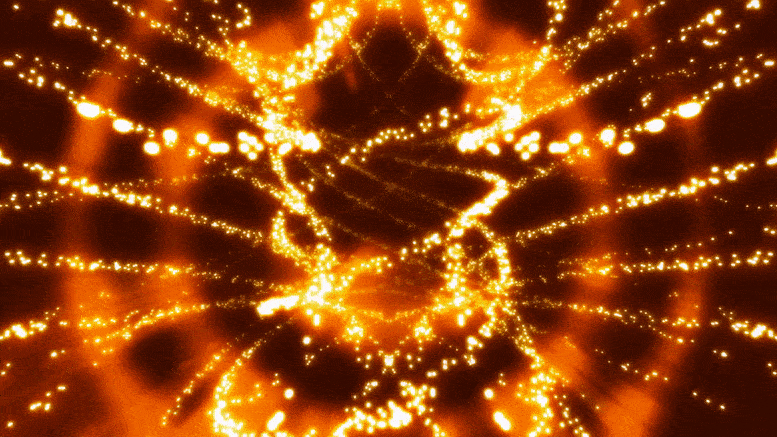
Un metamateriale innovativo con proprietà non convenzionali utilizza segnali elettrici per controllare la direzione e l’intensità delle onde di energia che attraversano un solido. Questo innovativo metamateriale, che ha un’unica densità di massa, offre un allontanamento dalla seconda legge di Newton, in quanto forza e accelerazione non vanno nella stessa direzione. Huang prevede applicazioni ad ampio raggio da usi militari e commerciali, come il controllo delle onde radar o la gestione delle vibrazioni dovute alla turbolenza dell’aria negli aerei, a usi civili come il monitoraggio della salute di strutture come ponti e condutture.
I ricercatori dell’Università del Missouri hanno progettato un prototipo di un metamateriale energetico piccolo e leggero in grado di controllare la direzione e l’intensità delle onde di energia.
Il professor Guoliang Huang dell’Università del Missouri ha sviluppato un prototipo di metamateriale in grado di controllare la direzione e l’intensità delle onde di energia utilizzando segnali elettrici. Il materiale innovativo ha potenziali applicazioni nei settori militare e commerciale e può anche essere utilizzato per monitorare la salute strutturale di ponti e oleodotti.
Per più di 10 anni, Guoliang Huang, Huber e Helen Croft Chair in Engineering presso l’Università del Missouri, ha ricercato le proprietà non convenzionali di “[{” attribute=””>metamaterials” — an artificial material that exhibits properties not commonly found in nature as defined by Newton’s laws of motion — in his long-term pursuit of designing an ideal metamaterial.
Huang’s goal is to help control the “elastic” energy waves traveling through larger structures — such as an aircraft — without light and small “metastructures.”

The prototype metamaterial uses electrical signals transported by these black wires to control both the direction and intensity of energy waves passing through a solid material. Credit: University of Missouri
“For many years I’ve been working on the challenge of how to use mathematical mechanics to solve engineering problems,” Huang said. “Conventional methods have many limitations, including size and weight. So, I’ve been exploring how we can find an alternative solution using a lightweight material that’s small but can still control the low-frequency vibration coming from a larger structure, like an aircraft.”

Guoliang Huang. Credit: University of Missouri
Now, Huang’s one step closer to his goal. In a new study published in the Proceedings of the National Academy of Sciences (PNAS) on May 18, Huang and colleagues have developed a prototype metamaterial that uses electrical signals to control both the direction and intensity of energy waves passing through a solid material.
Potential applications of his innovative design include military and commercial uses, such as controlling radar waves by directing them to scan a specific area for objects or managing vibration created by air turbulence from an aircraft in flight.
“This metamaterial has odd mass density,” Huang said. “So, the force and acceleration are not going in the same direction, thereby providing us with an unconventional way to customize the design of an object’s structural dynamics, or properties to challenge Newton’s second law.”
This is the first physical realization of odd mass density, Huang said.
“For instance, this metamaterial could be beneficial to monitor the health of civil structures such as bridges and pipelines as active transducers by helping identify any potential damage that might be hard to see with the human eye.”
Reference: “Active metamaterials for realizing odd mass density” by Qian Wu, Xianchen Xu, Honghua Qian, Shaoyun Wang, Rui Zhu, Zheng Yan, Hongbin Ma, Yangyang Chen and Guoliang Huang, 18 May 2023, Proceedings of the National Academy of Sciences.
DOI: 10.1073/pnas.2209829120
Other MU contributors include Qian Wu, Xianchen Xu, Honghua Qian, Shaoyun Wang, Zheng Yan and Hongbin Ma. Grants from the Air Force Office of Scientific Research and the Army Research Office funded the research.

“Devoto esploratore. Pluripremiato sostenitore del cibo. Esasperante umile fanatico della tv. Impenitente specialista dei social media.”


/cdn.vox-cdn.com/uploads/chorus_asset/file/25417925/garrys_mod_screenshot.jpg)

More Stories
Gli scienziati di Cambridge svelano una nuova teoria sulle origini degli elementi costitutivi della vita
Hubble celebra il suo 34° anniversario con una vista mozzafiato della Nebulosa Piccolo Manubrio
Sepolta nella Nebulosa Artiglio di Gatto c'è una delle particelle spaziali più grandi mai viste